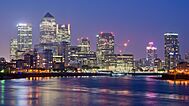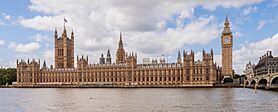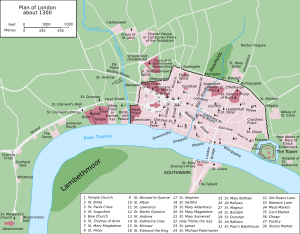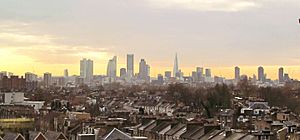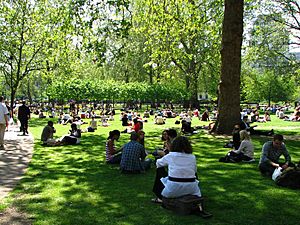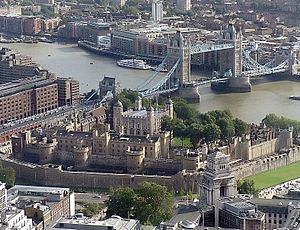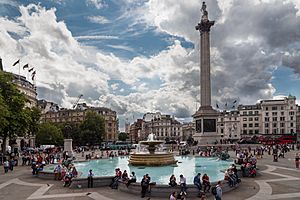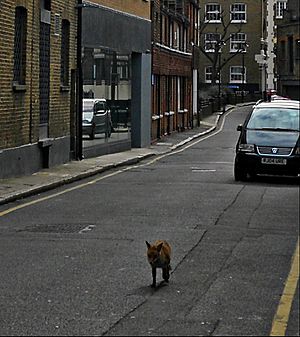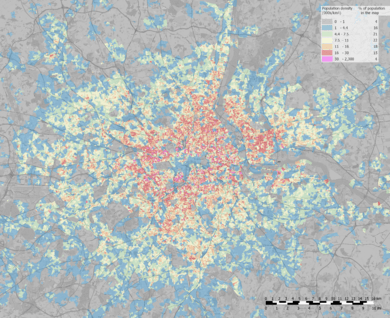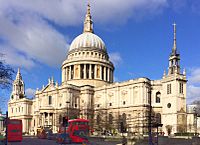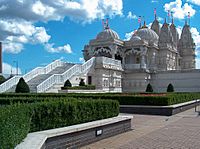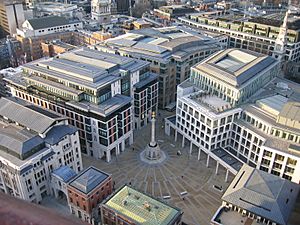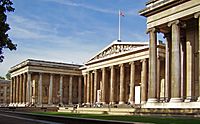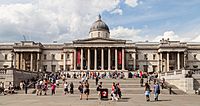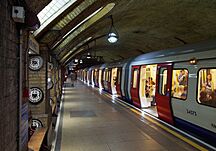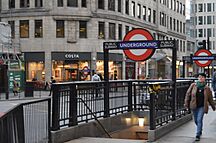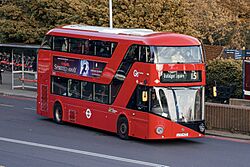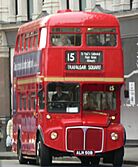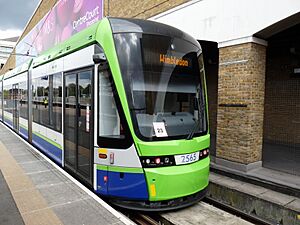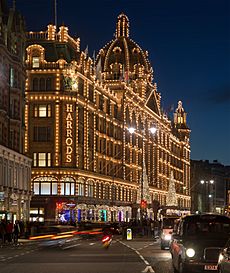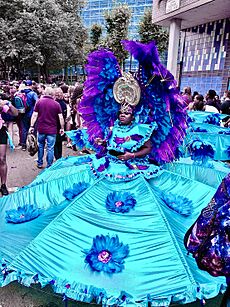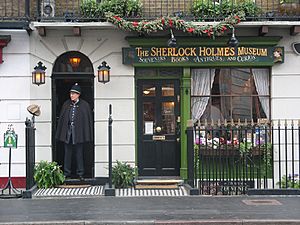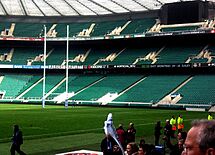London facts for kids
Quick facts for kids
London
|
|
|---|---|
|
River Thames and Tower Bridge with The Shard and Southwark (left), and Tower of London and City of London (right)
Palace of Westminster with Big Ben (right)
|
|
| Sovereign state | United Kingdom |
| Country | England |
| Region | London |
| Ceremonial counties | |
| Settled by Romans | AD 47, as Londinium |
| Administrative HQ | City Hall, Newham |
| Local government | 32 London boroughs and the City of London |
| Government | |
| • Type | Executive mayoralty and deliberative assembly |
| • Body | Greater London Authority |
| Area | |
| • Total | 607 sq mi (1,572 km2) |
| • Urban | 671 sq mi (1,738 km2) |
| • Metro | 3,236 sq mi (8,382 km2) |
| Population
(2022)
|
|
| • Total | 8,866,180 |
| • Rank |
|
| • Density | 14,600/sq mi (5,640/km2) |
| • Urban
(2011)
|
9,787,428 |
| • Metro
(2024)
|
14,900,000 |
| Demonyms | Londoner |
| Ethnicity (2021) | |
| • Ethnic groups |
List
|
| Religion (2021) | |
| • Religion |
List
40.7% Christianity
27.1% no religion 15.0% Islam 5.1% Hinduism 1.7% Judaism 1.6% Sikhism 0.9% Buddhism 1.0% other 7.0% not stated |
| Time zone | UTC+0 (GMT) |
| • Summer (DST) | UTC+1 (BST) |
| Postcode areas |
22 areas
E, EC, N, NW, SE, SW, W, WC, BR,
CM, CR, DA, EN, HA, IG, KT, RM, SM,UB, WD, TN, TW |
| Dialling codes |
|
| GSS code |
|
| GeoTLD | .london |
London is the capital and largest city of both England and the United Kingdom. It has a population of about 9 million people. Its wider metropolitan area is the biggest in Western Europe, with nearly 15 million residents. London sits on the River Thames in southeast England. It has been an important city for almost 2,000 years.
The oldest part of London is the City of London. It was founded by the Romans as Londinium and is still the city's financial heart. To the west, the City of Westminster has been home to the UK government and parliament for centuries. London grew very quickly in the 1800s, becoming the world's largest city at that time. Today, "London" usually refers to the larger area called Greater London. This area is managed by 33 local councils and the Greater London Authority.
London is a major global city. It has a big impact on art, entertainment, fashion, business, finance, education, and tourism. It has Europe's largest number of universities. Some of these are among the best in the world, like Imperial College London for science and London School of Economics for social sciences. London is the most visited city in Europe. It also has the world's busiest city airport system. The London Underground is the oldest subway system in the world.
London is very diverse, with over 300 languages spoken. Its population makes it Europe's third-most populous city. It accounts for a large part of the UK's population.
London is home to four World Heritage Sites. These include Kew Gardens, the Tower of London, and the Palace of Westminster (which includes Westminster Abbey). The historic area of Greenwich is also a World Heritage Site. Here, the Royal Observatory marks the prime meridian (0° longitude) and sets Greenwich Mean Time. Other famous landmarks are Buckingham Palace, the London Eye, Piccadilly Circus, St Paul's Cathedral, Tower Bridge, and Trafalgar Square. The city has many museums, art galleries, and libraries. These include the British Museum, National Gallery, and Natural History Museum. London also hosts big sporting events like the FA Cup Final and the Wimbledon Tennis Championships. It was the first city to host the Summer Olympic Games three times, including the 2012 Summer Olympics.
The Name of London
The name London is very old. It was first recorded in the first century AD as Londinium by the Romans. Experts believe the name came from an ancient Celtic language. It was then changed into Latin and later into Old English.
Until 1889, the name "London" only referred to the small area of the City of London. But since then, it has also included the larger areas known as the County of London and Greater London.
London's History

The Romans built a city called Londinium on the River Thames in AD 43. The name came from the Celtic language of the ancient Britons. In AD 61, Queen Boudica and her army destroyed the city. The Romans then rebuilt London, and it became an important trading city.
After the Romans left Britain, fewer people lived in London for a long time. This was because the Anglo-Saxons preferred living in the countryside. In the 9th century, more people began to live there again. London became the largest city in England. However, it did not become the official capital city until the 12th century.
After railways were built, London grew very large. Today, Greater London has 33 London Boroughs and a mayor. The old City of London is only one square mile in size. It has its own leader called the Lord Mayor.
Another famous old part of Greater London is Westminster. This was once a separate city from the City of London. In Westminster, you can find Westminster Abbey, the Palace of Westminster (also known as the Houses of Parliament with Big Ben), and 10 Downing Street. This is where the Prime Minister lives.
London's Geography
London's Landscape
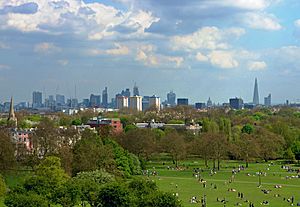
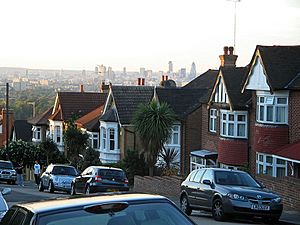
Greater London covers a total area of about 1,583 square kilometers (611 square miles). In 2001, it had a population of over 7 million people. The wider London Metropolitan Region is much larger. It covers about 8,382 square kilometers (3,236 square miles).
Modern London is built along the River Thames. This is its most important natural feature. The river is navigable, meaning boats can travel on it. It flows through the city from the southwest to the east. The Thames Valley is a flat area surrounded by gentle hills. These include Parliament Hill and Primrose Hill. The Thames used to be much wider and shallower. It had large marshlands along its banks.
Since the Victorian era, the Thames has been built up with embankments. Many of its smaller rivers now flow underground. The Thames is a tidal river, which means its water level changes with the ocean tides. London is at risk of flooding. This risk has grown because the high water level is slowly rising. This is due to Britain slowly tilting (north going up, south going down) after the last ice age.
To protect London from flooding, the Thames Barrier was built in 1974. This huge barrier is located across the Thames at Woolwich. It is expected to work until around 2070. Plans for making it bigger or redesigning it are already being discussed.
London's Climate
London has a mild oceanic climate, similar to other parts of southern England. Even though it has a reputation for being rainy, London actually gets less rain than cities like Rome or New York. Temperatures in the London area have ranged from 38.1 °C (100.6 °F) in August 2003 to -16.1 °C (3.0 °F) in January 1962.
Summers are usually warm and sometimes hot. The average high temperature in July is 24 °C (75 °F). London typically has about 31 days each year above 25 °C (77 °F). About 4 days a year, temperatures reach above 30 °C (86 °F). During the 2003 European heat wave, there were 14 days in a row above 30 °C (86 °F). For two of those days, temperatures reached 38 °C (100 °F).
Winters are generally cool and damp. There isn't much change in temperature. Snow falls sometimes and can cause travel problems. Snow is more common in the outer parts of London. Spring and autumn are mixed seasons and can be very pleasant. Because London is a large city, it has an "urban heat island" effect. This means the city centre can be up to 5 °C (9 °F) warmer than the suburbs.
London's Districts
London's huge urban area is often described using many district names. Examples include Bloomsbury, Mayfair, Wembley, and Whitechapel. These names are informal. They often come from villages that London has grown to include. Or they are old administrative areas like parishes.
These names are still used today because of tradition. Each name refers to a local area with its own special feel. However, they do not have official borders. Since 1965, Greater London has been divided into 32 London boroughs. The ancient City of London is also a separate area. The City of London is the main financial district. Canary Wharf has also become a new financial and business hub in the London Docklands to the east.
The West End is London's main area for entertainment and shopping. It attracts many tourists.
The East End is the area closest to the old Port of London. It is known for its large immigrant population. It was also one of the poorer areas in London. The surrounding East London area saw a lot of early industrial growth. Now, old industrial sites are being redeveloped. This includes the Lower Lea Valley, which became the Olympic Park for the 2012 Summer Olympics.
London's Architecture
London's buildings are very varied. They don't really fit into one architectural style. This is partly because they were built at different times. Many grand houses and public buildings, like the National Gallery, are made from Portland stone. Some parts of the city, especially west of the centre, have white stucco or whitewashed buildings.
Few buildings in central London are older than the Great Fire of London in 1666. These include some Roman remains, the Tower of London, and a few Tudor buildings. Further out, you can find Tudor-period Hampton Court Palace. This is England's oldest surviving Tudor palace, built around 1515.
Christopher Wren's churches from the late 1600s are important. So are the financial buildings from the 1700s and 1800s, like the Royal Exchange and the Bank of England. The Old Bailey from the early 1900s and the Barbican Estate from the 1960s also add to London's varied architecture.
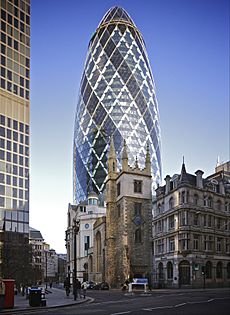
The old Battersea Power Station by the river in the southwest is a famous landmark. Some railway stations are great examples of Victorian architecture. These include St. Pancras and Paddington. London's density varies. The central area has many businesses. Inner London has many homes, and Outer London has fewer.
The Monument in the City of London offers views of the area. It remembers the Great Fire of London, which started nearby. Marble Arch and Wellington Arch have royal connections. So do the Albert Memorial and Royal Albert Hall in Kensington. Nelson's Column is a famous monument in Trafalgar Square, a main spot in central London. Older buildings are mostly made of brick. They often use yellow London stock brick or a warm orange-red brick. These are often decorated with carvings and white plaster mouldings.
In busy areas, most buildings are medium or high-rise. London's skyscrapers, like 30 St Mary Axe ("the Gherkin") and The Shard, are mostly in the two financial districts. These are the City of London and Canary Wharf. Very tall buildings are sometimes limited if they block views of St Paul's Cathedral or other historic sites. However, London has many tall skyscrapers. The 95-storey Shard London Bridge is the tallest building in the European Union.
Other notable modern buildings include City Hall in Southwark. It has a unique oval shape. The British Library is in Somers Town/Kings Cross. What was once the Millennium Dome is now an entertainment venue called the O2 Arena. It is located by the Thames, east of Canary Wharf.
London's Wildlife and Green Spaces
London is known as "one of the World's Greenest Cities." Over 40 percent of the city is green space or open water. More than 2,000 types of flowering plants grow here. The tidal Thames river is home to 120 species of fish. Over 60 types of birds nest in central London. Experts have also recorded 47 types of butterflies and over 270 kinds of spiders. London's wetland areas support important populations of many water birds. London has 38 Sites of Special Scientific Interest (SSSIs). It also has two National Nature Reserves and 76 Local Nature Reserves.
Amphibians are common in London. These include smooth newts living near the Tate Modern. You can also find common frogs, common toads, palmate newts, and great crested newts. Native reptiles like slow-worms, common lizards, grass snakes, and adders are mostly seen in Outer London.
London is home to about 10,000 foxes. This means there are about 16 foxes for every square mile (2.6 square kilometers). These city foxes are bolder than country foxes. They sometimes walk on pavements with people. They even raise their cubs in people's backyards.
Foxes have even entered the Houses of Parliament. One was found asleep on a filing cabinet! Another got into Buckingham Palace grounds. It reportedly killed some of Queen Elizabeth II's pink flamingos. Generally, however, foxes and city residents seem to get along well.
Other mammals in Greater London include hedgehogs, rats, mice, rabbits, shrews, voles, and squirrels. In wilder parts of Outer London, like Epping Forest, you can find more animals. These include hares, badgers, and weasels. Herds of red and fallow deer roam freely in Richmond Park and Bushy Park.
London's People
| Country of birth | Population | Percent | |
|---|---|---|---|
| 5,223,986 | 59.4 | ||
| Non-United Kingdom | 3,575,739 | 40.6 | |
| 322,644 | 3.7 | ||
| 175,991 | 2.0 | ||
| 149,397 | 1.7 | ||
| 138,895 | 1.6 | ||
| 129,774 | 1.5 | ||
| 126,059 | 1.4 | ||
| 117,145 | 1.3 | ||
| 96,566 | 1.1 | ||
| 80,379 | 0.9 | ||
| 77,715 | 0.9 | ||
| Others | 2,161,174 | 24.6 | |
| Total | 8,799,725 | 100.0 | |
London's urban area extends beyond Greater London. In 2011, it had over 9.7 million people. Its wider metropolitan area has between 12 and 14 million people. London is the second most populous metropolitan area in Europe. Between 1991 and 2001, about 726,000 immigrants moved to London.
The region covers about 1,579 square kilometers (609 square miles). This gives it a population density of about 5,177 people per square kilometer (13,408 per square mile). This is more than ten times higher than any other British region. In terms of population, London is the 19th largest city globally. It is also the 18th largest metropolitan region.
In 2021, 23.1% of Londoners rented their homes from councils or housing associations. 46.8% owned their homes, either outright or with a mortgage. 30% rented privately. Many Londoners work from home; 42.9% did so in 2021. 20.6% drive a car to work. The number of people taking the train and underground decreased. It went from 22.6% in 2011 to 9.6% in 2021. In terms of education, 46.7% of Londoners had university degrees or higher in 2021. 16.2% had no qualifications.
Age and Population
London has one of the youngest populations in the UK. In 2018, the average age of London residents was 36.5 years old. This was younger than the UK average of 40.3 years.
Children under 14 made up 20.6% of the population in Outer London in 2018. In Inner London, they made up 18%. The 15–24 age group was 11.1% in Outer London and 10.2% in Inner London. People aged 25–44 years were 30.6% in Outer London and 39.7% in Inner London. Those aged 45–64 years were 24% in Outer London and 20.7% in Inner London. People aged 65 and over were 13.6% in Outer London, but only 9.3% in Inner London.
People from Other Countries
The 2021 census showed that 3,575,739 people, or 40.6% of London's population, were born outside the UK. This makes London one of the cities with the largest immigrant populations. This number has grown by about 3 million since 1971.
Of the foreign-born population, 13% were born in Asia. 7.1% were born in Africa. 15.5% were born in other European countries. 4.2% were born in the Americas and Caribbean. The five largest groups came from India, Romania, Poland, Bangladesh, and Pakistan.
About 56.8% of children born in London in 2021 had a mother who was born abroad. This trend has been increasing. In 2001, foreign-born mothers made up 43.3% of births. By 2006, they were the majority at 52.5%.
Many foreign-born people counted in the 2021 census arrived recently. 16.6% of London's total population arrived between 2011 and 2021. 10.4% arrived between 2001 and 2010. 5.7% arrived between 1991 and 2001. 7.3% arrived before 1990.
Ethnic Groups in London
According to the 2011 Census, 59.8% of London's 8.1 million residents were White. This included 44.9% White British and 12.1% classified as "Other White." About 20.9% of Londoners were of Asian and mixed-Asian descent. Indians made up 6.6% of the population. Pakistanis and Bangladeshis each made up 2.7%. Chinese people were 1.5%, and Arabs were 1.3%. Another 4.9% were classified as "Other Asian."
15.6% of London's population was of Black and mixed-Black descent. Black Africans made up 7.0% of London's population. Black Caribbean people were 4.2%. 5.0% were of mixed race. The history of African people in London goes back to the Roman period.
In 2007, one-fifth of primary school children in London were from ethnic minority groups. In 2011, of London's 1.6 million people aged 0 to 15, 46.4% were White. 19.8% were Asian, 19% Black, 10.8% Mixed, and 4% were another ethnic group. A 2005 survey found that over 300 languages were spoken in London. More than 50 non-native communities had populations over 10,000. In 2010, London's foreign-born population was 2.65 million (33%). This was up from 1.63 million in 1997.
The 2011 census showed that 36.7% of Greater London's population was born outside the UK. The five largest foreign-born groups living in London from July 2009 to June 2010 were from India, Poland, the Republic of Ireland, Bangladesh, and Nigeria.
Languages Spoken in London
In January 2005, a study on London's diversity found that over 300 languages are spoken in the city. More than 50 non-native communities have populations larger than 10,000 people. In the 2021 census, 78.4% of Londoners spoke English as their main language. The five biggest languages spoken after English were Romanian, Spanish, Polish, Bengali, and Portuguese.
Religion in London
According to the 2011 Census, the largest religious group was Christians (48.4%). This was followed by those with no religion (20.7%). Muslims made up 12.4% of the population. Hindus were 5.0%. Jews were 1.8%, Sikhs 1.5%, and Buddhists 1.0%.
London has traditionally been a Christian city. It has many churches, especially in the City of London. St Paul's Cathedral and Southwark Cathedral are important Anglican centres. The Archbishop of Canterbury, the main bishop of the Church of England, lives at Lambeth Palace.
Important national and royal ceremonies take place at St Paul's and Westminster Abbey. Westminster Abbey is different from the nearby Westminster Cathedral. Westminster Cathedral is the largest Roman Catholic cathedral in England and Wales. Even with many Anglican churches, fewer people attend services in this denomination. Church attendance continues to decline.
London also has large Muslim, Hindu, Sikh, and Jewish communities.
Notable mosques include the East London Mosque in Tower Hamlets. It is allowed to broadcast the Islamic call to prayer. The London Central Mosque is near Regent's Park. The Baitul Futuh belongs to the Ahmadiyya Muslim Community. After the oil boom, more wealthy Middle-Eastern Arab Muslims settled around Mayfair, Kensington, and Knightsbridge in West London. There are large Bengali Muslim communities in the eastern boroughs of Tower Hamlets and Newham.
Large Hindu communities are found in the northwestern boroughs of Harrow and Brent. Brent was home to Europe's largest Hindu temple, Neasden Temple, until 2006. London has 44 Hindu temples. There are Sikh communities in East and West London, especially in Southall. Southall has one of the largest Sikh populations and the largest Sikh temple outside India.
Most British Jews live in London. Notable Jewish communities are in Stamford Hill, Stanmore, Golders Green, Finchley, Hampstead, Hendon, and Edgware in North London. Bevis Marks Synagogue in the City of London is part of London's historic Sephardic Jewish community. It is the only synagogue in Europe to have held services continuously for over 300 years. Stanmore and Canons Park Synagogue has the most members of any Orthodox synagogue in Europe. The London Jewish Forum was created in 2006.
London's Accents
Cockney is an accent heard across London. It is mainly spoken by working-class and lower-middle class Londoners. It is often linked to the East End and wider East London, where it started in the 1700s. However, the Cockney way of speaking might be much older. Today, Cockney dialect is less common in some parts of the East End itself. Modern strongholds include other parts of London and suburbs in the home counties.
Estuary English is an accent between Cockney and Received Pronunciation. It is widely spoken by people of all classes in London and southeast England. It is linked to the River Thames and its estuary.
Multicultural London English (MLE) is a new accent. It is becoming more common in diverse areas among young, working-class people. It mixes different ethnic accents, especially Afro-Caribbean and South Asian, with a strong Cockney influence.
Received Pronunciation (RP) is the accent traditionally seen as the standard for British English. It doesn't have a specific geographical area. However, it is traditionally defined as the standard speech used in London and southeast England. It is mainly spoken by upper-class and upper-middle class Londoners.
London's Economy

London's economy is very strong. In 2019, its total economic output was £503 billion. This is about a quarter of the entire UK economy. London has five main business areas: the City, Westminster, Canary Wharf, Camden & Islington, and Lambeth & Southwark. The City has the most office space, with 8 million square meters. London also has some of the highest property prices in the world.
The City of London: A Financial Hub
London's finance industry is based in the City of London and Canary Wharf. These are the two main business districts. London became a major financial centre after 1795. This was when the Dutch Republic collapsed due to the Napoleonic wars. Many bankers moved from Amsterdam to London. Also, London's market-focused system became more important in the 1700s. The city's financial strength was also boosted by a strong Jewish community from across Europe.
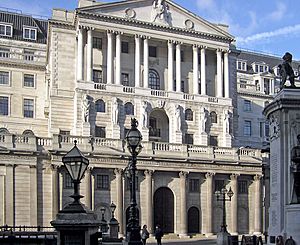
By the mid-1800s, London was the top financial centre. By the end of that century, over half of the world's trade was financed in British money. As of 2023, London ranks second in the world for financial centres.
Finance is London's biggest industry. Its financial exports contribute a lot to the UK's economy. Even after some stock listings moved from the London Stock Exchange due to Brexit, London remains a very strong economic city in Europe. It is still one of the world's major financial centres. It is the world's largest currency trading centre. About 37% of the daily global currency trading happens here. Over 85% of people working in Greater London are in service industries. London's economy was affected by the financial crisis of 2007–2008. However, by 2010, the city had recovered. It put new rules in place and regained its economic strength. Along with many business headquarters, the City of London is home to the Bank of England, London Stock Exchange, and Lloyd's of London insurance market. Barclays, founded in 1690, is one of the oldest banks still operating. Its branch in Enfield installed the first cash machine (ATM) in 1967.
Over half of the UK's top 100 companies (the FTSE 100) have their main offices in central London. Over 100 of Europe's 500 largest companies are also based there. More than 70% of the FTSE 100 companies are in London's metropolitan area. 75% of Fortune 500 companies have offices in London.
Media and Technology in London
Many media companies are based in London. The media distribution industry is London's second most competitive sector. The BBC, the world's oldest national broadcaster, is a big employer. Other broadcasters like ITV, Channel 4, Channel 5, and Sky also have their main offices in the city. Many national newspapers, including The Times (founded in 1785), are edited in London. The term Fleet Street is still used to refer to the British national press. The communications company WPP is the world's largest advertising agency.
A large number of technology companies are based in London. Many are in East London Tech City, also known as Silicon Roundabout. In 2014, London was one of the first cities to get a geoTLD. In February 2014, London was named the European City of the Future.
Tourism in London
London is one of the top tourist destinations in the world. It is also the city with the most money spent by international visitors. In 2015, this was estimated at over US$20 billion. Tourism is a main industry in London. It employed 700,000 full-time workers in 2016. It adds £36 billion a year to the economy. The city accounts for 54% of all money spent by visitors to the UK.
In 2015, the top ten most-visited attractions in the UK were all in London:
- British Museum: 6,820,686 visitors
- National Gallery: 5,908,254 visitors
- Natural History Museum (South Kensington): 5,284,023 visitors
- Southbank Centre: 5,102,883 visitors
- Tate Modern: 4,712,581 visitors
- Victoria and Albert Museum (South Kensington): 3,432,325 visitors
- Science Museum: 3,356,212 visitors
- Somerset House: 3,235,104 visitors
- Tower of London: 2,785,249 visitors
- National Portrait Gallery: 2,145,486 visitors
In 2023, London had 155,700 hotel rooms. This number is expected to grow to 183,600 rooms. This is more than any city outside China. Luxury hotels include the Savoy (opened 1889) and the Ritz (opened 1906). Budget hotel chains include Premier Inn and Travelodge.
Getting Around London: Transport
The Mayor of London manages transport policy. However, the mayor does not control the longer-distance train network. In 2007, the Mayor took over some local train lines. These now form the London Overground network. The Mayor also manages the London Underground, trams, and buses. Transport for London (TfL) runs the public transport network.
The London Underground, trams, and buses became one system in 1933. This was when the London Passenger Transport Board was created. Transport for London is now responsible for most of London's transport. It is run by a board and a commissioner chosen by the Mayor of London.
London's Airports
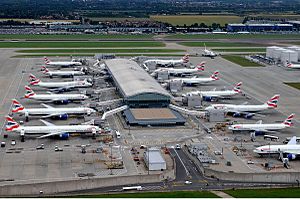
London is a major international air travel hub. It has the busiest city airspace in the world. Eight airports use "London" in their name. Most flights go through six of these. Other airports also serve London, mainly for private flights.
- Heathrow Airport, in Hillingdon, West London, was the busiest airport in the world for international traffic for many years. It is the main hub for British Airways. Its fifth terminal opened in March 2008.
- Gatwick Airport, south of London in West Sussex, handles flights to more places than any other UK airport. It is the main base for easyJet.
- London Stansted Airport, northeast of London in Essex, serves the most European destinations of any UK airport. It is the main base for Ryanair.
- Luton Airport, north of London in Bedfordshire, is used by budget airlines like easyJet and Wizz Air for short flights.
- London City Airport, the most central airport, is in Newham, East London. It focuses on business travellers.
- London Southend Airport, east of London in Essex, is a smaller, regional airport. It handles short flights on a growing number of airlines. In 2017, over 95% of its passengers were international.
London's Rail Network
Underground and DLR Trains
The London Underground, also called the Tube, opened in 1863. It is the oldest and third longest metro system in the world. It serves 272 stations. It was formed from several private companies. The world's first underground electric line, the City and South London Railway, opened in 1890.
Over four million journeys are made on the Underground every day. More than 1 billion journeys are made each year. A large investment program is trying to reduce crowding and improve reliability. £6.5 billion was spent before the 2012 Summer Olympics. The Docklands Light Railway (DLR) opened in 1987. It is a second, more local metro system. It uses smaller, lighter tram-like vehicles. It serves the London Docklands, Greenwich, and Lewisham.
Suburban Trains
There are 368 railway stations in the London Travelcard Zones. These are part of a large above-ground suburban railway network. South London has many railways because it has fewer Underground lines. Most train lines end in central London, at eighteen terminal stations. The Thameslink trains are an exception. They connect Bedford in the north to Brighton in the south. They also pass through Luton and Gatwick airports. London has Britain's busiest station by passengers: Waterloo. Over 184 million people use this station complex each year. Clapham Junction is one of Europe's busiest train interchanges.
More train capacity was needed. So, the Elizabeth Line (Crossrail) opened in May 2022. It is a new railway line running east to west through London. It also goes into the Home Counties and has a branch to Heathrow Airport. It was Europe's biggest construction project, costing £15 billion.
Inter-city and International Trains

London is the centre of the National Rail network. 70% of all train journeys in the UK start or end in London. King's Cross station and Euston station are the starting points for the two main railway lines in Britain. These are the East Coast Main Line and the West Coast Main Line. Like suburban trains, regional and inter-city trains leave from several stations in central London. They connect London directly with most major cities and towns in Great Britain. The Flying Scotsman is an express train service. It has run between London and Edinburgh since 1862. The famous steam locomotive named after this service, Flying Scotsman, was the first to reach 100 miles per hour (161 km/h) in 1934.
Some international train services to Continental Europe ran in the 1900s as boat trains. The Channel Tunnel opened in 1994. This connected London directly to the European rail network. This allowed Eurostar services to begin. Since 2007, high-speed trains link St. Pancras International with Lille, Calais, Paris, Brussels, and Amsterdam. These trains use the High Speed 1 rail link and the Channel Tunnel. The first high-speed domestic trains started in June 2009. They connect Kent to London. There are plans for a second high-speed line. This would link London to the Midlands, North West England, and Yorkshire.
Buses, Coaches, and Trams
London's bus network runs 24 hours a day. It has about 9,300 vehicles and over 675 bus routes. There are about 19,000 bus stops. In 2019, the network had over 2 billion passenger trips each year. Since 2010, it has earned about £1.2 billion in revenue annually. London has one of the largest wheelchair-accessible bus networks in the world. Since 2007, audio-visual announcements have been added. This makes it more accessible for passengers with hearing and visual impairments.
The red double-decker bus is a symbol of London. It first appeared in the city in 1947. London's main coach station is Victoria Coach Station. It opened in 1932. It handles over 14 million passengers a year. It provides services across the UK and to Europe.
There is a modern tram network in South London called Tramlink. It has 39 stops and four routes. In 2013, it carried 28 million people. Since June 2008, Transport for London has fully owned and operated Tramlink.
London's Cable Car
London's first and only cable car is the London Cable Car. It opened in June 2012. The cable car crosses the Thames River. It connects Greenwich Peninsula with the Royal Docks in East London. It can carry up to 2,500 passengers per hour in each direction during busy times.
Cycling in London
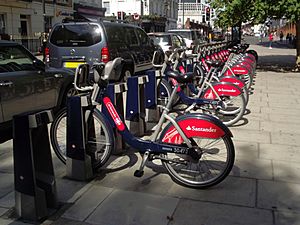
In the Greater London Area, about 670,000 people use a bike every day. This means about 7% of the total population cycles daily. Cycling has become a very popular way to travel in London. A bicycle hire scheme was launched in July 2010. It has been very successful and well-liked.
Port and River Boats
The Port of London was once the largest in the world. Now, it is the second-largest in the United Kingdom. In 2009, it handled 45 million tonnes of cargo each year. Most of this cargo goes through the Port of Tilbury, which is outside Greater London.
London has river boat services on the Thames called Thames Clippers. They offer both commuter and tourist boat services. At major piers like Canary Wharf and London Eye, boats leave every 20 minutes during busy times. The Woolwich Ferry carries 2.5 million passengers every year. It links the North and South Circular Roads.
London's Roads
Most journeys in central London are made by public transport. However, car travel is common in the suburbs. The inner ring road goes around the city centre. The North and South Circular roads are just inside the suburbs. The outer orbital motorway, the M25, is mostly outside the built-up area. These roads circle the city. Many busy roads connect to them, but few motorways go into inner London. The M25 is the second-longest ring-road motorway in Europe, at 117 miles (188 km) long. The A1 and M1 connect London to Leeds, Newcastle, and Edinburgh.
The Austin Motor Company started making hackney carriages (London taxis) in 1929. Models include the Austin FX3 from 1948 and the Austin FX4 from 1958. Newer models are the TXII and TX4, made by London Taxis International. The BBC says that "ubiquitous black cabs and red double-decker buses all have long and tangled stories that are deeply embedded in London's traditions." Taxis are traditionally black, but some are painted other colours or have advertisements.
London is known for its traffic jams. In 2009, the average car speed during rush hour was 10.6 miles per hour (17.1 km/h). In 2003, a congestion charge was introduced. This was to reduce traffic in the city centre. With a few exceptions, drivers must pay to drive within a certain zone in central London. Residents of this zone can buy a much cheaper pass. Over several years, the average number of cars entering central London on a weekday dropped from 195,000 to 125,000.
Low Traffic Neighbourhoods (LTN) were widely introduced in London. However, in 2023, the government stopped funding them. This happened even though their benefits were much greater than their costs.
Learning in London: Education
Universities and Higher Education



London is a major global centre for higher education and research. It has the largest number of higher education institutes in Europe. According to the QS World University Rankings 2015/16, London has the most top universities in the world. Its international student population of about 110,000 is larger than any other city. A 2014 report called London the global capital of higher education.
Several world-leading universities are in London. In the 2022 QS World University Rankings, Imperial College London was ranked 6th in the world. University College London (UCL) was 8th, and King's College London (KCL) was 37th. Imperial College is also the UK's leading university for research. The London School of Economics (LSE) is considered the world's top social science institution. The London Business School is one of the world's leading business schools. In 2015, its MBA program was ranked second-best globally. London also has three of the world's top ten performing arts schools. These include the Royal College of Music and the Royal Academy of Music.
The federal University of London is the largest teaching university in the UK. It has many students in London and around 48,000 in University of London Worldwide. It includes five large universities: City, King's College London, Queen Mary, Royal Holloway, and UCL. It also has smaller, more specialized institutions.
Universities in London outside the University of London system include Brunel University and London Metropolitan University. There are also three international universities.
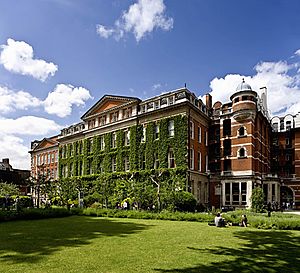
London has five major medical schools. These include Barts and The London School of Medicine and Dentistry and Imperial College School of Medicine. It also has many teaching hospitals. London is a major centre for biomedical research. Three of the UK's eight academic health science centres are in the city. These are Imperial College Healthcare, King's Health Partners, and UCL Partners. Many new biomedical and biotechnology companies from these research places are based in London. The first nursing school was founded by Florence Nightingale at St Thomas' Hospital in 1860. It is now part of King's College London. In 1952, a team at King's, led by Rosalind Franklin, took Photo 51. This was key evidence in finding the structure of DNA. London also has several business schools.

London is home to many special arts education institutions. These include famous drama schools like RADA (Royal Academy of Dramatic Art) and the London Academy of Music and Dramatic Art (LAMDA). There are also schools for ballet, dance, and circus arts. The Royal College of Art is here. The BRIT School in Croydon trains students for performing arts.
Primary and Secondary Education
Most primary and secondary schools and colleges in London are run by the London boroughs or funded by the state. Good examples include Ashbourne College and Brampton Manor Academy. There are also many private schools in London. Some are old and famous, like City of London School, Harrow, and Westminster School.
Royal Observatory and Scientific Societies

The Royal Observatory in Greenwich was founded in 1675. Its purpose was to help sailors find their longitude (position east or west). This important work led to Greenwich becoming the international prime meridian (0° longitude) in 1884. It also helped set Greenwich Mean Time.
Important scientific groups in London include the Royal Society. This is the UK's national academy of sciences and the oldest scientific institution in the world, founded in 1660. The Royal Institution was founded in 1799. Since 1825, the Royal Institution Christmas Lectures have taught science to the public. Famous speakers include Michael Faraday and David Attenborough.
London's Culture and Fun
Leisure and Entertainment
Leisure and entertainment are a big part of London's economy. A 2003 report said that London accounts for a quarter of the UK's entire leisure economy. The city is one of the four fashion capitals of the world. It is the world's third-busiest film production centre. London also has more live comedy shows and the biggest theatre audience of any city in the world.
In the City of Westminster, the West End is London's entertainment district. It focuses around Leicester Square, where film premieres are held. Piccadilly Circus has huge electronic advertisements. London's theatre district is here, along with many cinemas, bars, clubs, and restaurants. This includes the city's Chinatown district in Soho. Just to the east is Covent Garden, an area with special shops. In 1881, the West End's Savoy Theatre became the first public building in the world lit entirely by electricity. The city is home to Andrew Lloyd Webber, whose musicals have been very popular. Agatha Christie's The Mousetrap is the world's longest-running play. It has been performed in the West End since 1952. The Laurence Olivier Awards are given annually for theatre. The Royal Ballet, English National Ballet, Royal Opera, and English National Opera are based in London. They perform at the Royal Opera House and other venues.
Islington's Upper Street has more bars and restaurants than any other street in the UK. Europe's busiest shopping area is Oxford Street. It is almost 1 mile (1.6 km) long, making it the longest shopping street in the UK. It has many shops and department stores, including Selfridges. Knightsbridge is home to the famous Harrods department store. London is one of the world's largest shopping destinations. Hamleys is the oldest toy store in the world. It opened in 1760. Madame Tussauds wax museum opened in Baker Street in 1835. This era is seen as the start of London's tourism industry.
London is home to famous designers like Stella McCartney and Jimmy Choo. Its art and fashion schools make it one of the four international fashion centres. Mary Quant designed the miniskirt in her King's Road shop in the Swinging Sixties. In 2017, London was ranked the top city for new luxury stores. London Fashion Week happens twice a year.
London offers a huge variety of food. This is because of its diverse population. You can find Bangladeshi restaurants in Brick Lane and Chinese restaurants in Chinatown. There are Chinese takeaways and Indian restaurants all over London. Around 1860, the first fish and chips shop in London opened in Bow. The full English breakfast dates from the Victorian era. Many cafes in London serve it all day. London has five 3-Michelin star restaurants. Many hotels offer traditional afternoon tea.

London has many annual events. These include the New Year's Day Parade and fireworks at the London Eye. The world's second largest street party, the Notting Hill Carnival, is held every August. Traditional parades include November's Lord Mayor's Show. This event celebrates the new Lord Mayor of the City of London. June's Trooping the Colour is a military parade to celebrate the King's Official Birthday. The Boishakhi Mela is a Bengali New Year festival. It is the largest open-air Asian festival in Europe. The RHS Chelsea Flower Show takes place every May.
Literature, Film, and Television in London
London has been the setting for many books. The pilgrims in Geoffrey Chaucer's Canterbury Tales (late 1300s) started their journey from London. William Shakespeare lived and worked in London for much of his life. His friend Ben Jonson also lived there. Some of Jonson's plays, like The Alchemist, are set in the city. A Journal of the Plague Year (1722) by Daniel Defoe tells a fictional story of the 1665 Great Plague.
London's literary centres have traditionally been hilly Hampstead and Bloomsbury. Writers linked to the city include Samuel Pepys, who wrote about the Great Fire of London. Charles Dickens described a foggy, grimy London with street sweepers and pickpockets. This image has shaped how people see early Victorian London. Virginia Woolf was a leading modernist writer of the 1900s. Later important stories about London include Arthur Conan Doyle's Sherlock Holmes stories. Robert Louis Stevenson wrote Strange Case of Dr Jekyll and Mr Hyde (1886), a gothic story set in Victorian London. In 1898, H. G. Wells' sci-fi novel The War of the Worlds shows London being invaded by Martians.
Modern writers influenced by London include Peter Ackroyd, who wrote London: The Biography. In the 1940s, George Orwell wrote essays for the London Evening Standard. The evacuation of children from London during WWII is shown in C. S. Lewis' The Lion, the Witch and the Wardrobe (1950). On Christmas Eve 1925, Winnie-the-Pooh first appeared in London's Evening News. The character was based on a toy A. A. Milne bought for his son in Harrods. In 1958, Michael Bond created Paddington Bear, a refugee found at Paddington station. Buckingham Palace is featured in Roald Dahl's 1982 novel The BFG.
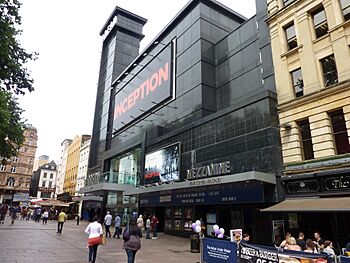
London has played a big role in the film industry. Major studios near London include Pinewood and Leavesden. The James Bond and Harry Potter series were filmed here. Many post-production companies are in Soho. London has six of the world's largest visual effects companies. The Imaginarium is a digital performance-capture studio founded by Andy Serkis. London has been the setting for films like Oliver Twist (1948), Mary Poppins (1964), and Paddington (2014). Famous actors and filmmakers from London include Charlie Chaplin, Alfred Hitchcock, Michael Caine, and Emma Thompson. The largest cinema chain in the country, Odeon Cinemas, was founded in London in 1928. The BFI IMAX on the South Bank is the largest cinema screen in the UK. The British Academy Film Awards (BAFTAs) have been held in London since 1949. The BFI London Film Festival takes place every October.
London is a major centre for television production. Studios include Television Centre and ITV Studios. These studios hosted shows like Pop Idol, The X Factor, and Britain's Got Talent. Many TV shows have been set in London, including the popular soap opera EastEnders.
Museums, Art Galleries, and Libraries
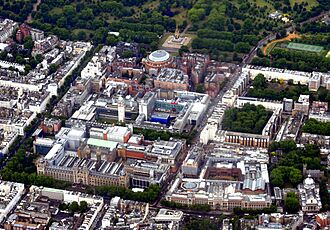
London is home to many museums, galleries, and other institutions. Many of them are free to enter. They are major tourist attractions and also do research. The first of these was the British Museum in Bloomsbury, founded in 1753. It originally held old objects, natural history items, and the national library. Now, it has 7 million items from around the world. In 1824, the National Gallery was founded. It holds the British national collection of Western paintings. It is now in a famous spot in Trafalgar Square.
The British Library is the second largest library in the world. It is the national library of the United Kingdom. There are many other research libraries, like the Wellcome Library. There are also university libraries, such as the British Library of Political and Economic Science at LSE.
In the late 1800s, the area of South Kensington became "Albertopolis". This was a cultural and scientific area. Three major national museums are there: the Victoria and Albert Museum, the Natural History Museum, and the Science Museum. The National Portrait Gallery was founded in 1856. It holds pictures of important figures from British history. Its collection is now the largest of portraits in the world. The national gallery of British art is at Tate Britain. It was first an annex of the National Gallery in 1897. The Tate Gallery also became a major centre for modern art. In 2000, this collection moved to Tate Modern. This new gallery is in the old Bankside Power Station. People can reach it by walking across the Millennium Bridge over the Thames.
London's Music Scene

London is a major capital for classical and popular music. It is home to big music companies like Universal Music Group International. The city also has many orchestras and concert halls. These include the Barbican Arts Centre (home of the London Symphony Orchestra) and the Southbank Centre (London Philharmonic Orchestra). The Royal Albert Hall hosts The Proms. The Proms is an eight-week summer festival of classical music. It ends with the famous Last Night of the Proms. London's two main opera houses are the Royal Opera House and the London Coliseum. Several conservatoires are in the city, like the Royal Academy of Music. The record label EMI was formed in London in 1931. Alan Blumlein created stereo sound there that year. Guitar amp engineer Jim Marshall founded Marshall Amplification in London in 1962.
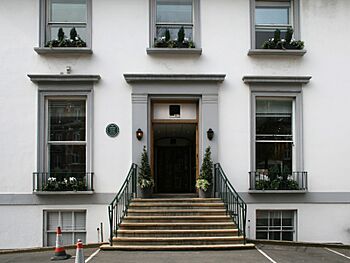
London has many places for rock and pop concerts. These include the world's busiest indoor venue, the O2 Arena, and Wembley Arena. Many music festivals are held in London, such as the Wireless Festival and Lovebox.
The city is home to the first Hard Rock Cafe. It also has the Abbey Road Studios, where the Beatles recorded many songs. In the 1960s, 70s, and 80s, many famous musicians came from London. These include Elton John, Pink Floyd, David Bowie, the Rolling Stones, and Queen.
London was important in the development of punk music. Groups like the Sex Pistols and the Clash were based in the city. Other artists from London include George Michael, Kate Bush, Adele, Sam Smith, and Ed Sheeran. London artists also played a big role in synth-pop. These include Gary Numan and Depeche Mode. London is also a centre for urban music. Genres like UK garage, drum and bass, dubstep, and grime grew here. Urban acts from London include Stormzy and M.I.A.. The British Phonographic Industry's annual music awards, the Brit Awards, are held in London.
Fun and Games in London
Parks and Green Spaces

A 2013 report said London is the "greenest city" in Europe. It has 35,000 acres (14,164 hectares) of public parks, woodlands, and gardens. The largest parks in central London are three of the eight Royal Parks. These are Hyde Park and Kensington Gardens in the west, and Regent's Park to the north. Hyde Park is popular for sports and sometimes hosts outdoor concerts. Regent's Park has London Zoo, the world's oldest scientific zoo. Primrose Hill is a great spot to see the city skyline.
Close to Hyde Park are smaller Royal Parks: Green Park and St. James's Park. Many large parks are outside the city centre. These include Hampstead Heath and the Royal Parks of Greenwich Park, Bushy Park, and Richmond Park (the largest). Hampton Court Park is also a royal park.
Near Richmond Park is Kew Gardens. It has the world's largest collection of living plants. In 2003, the gardens became a UNESCO World Heritage Site. London also has parks managed by its borough councils. These include Victoria Park in the East End and Battersea Park in the centre. Some more natural open spaces exist, like Hampstead Heath and Epping Forest. Hampstead Heath includes Kenwood House, where classical music concerts are held in summer. Epping Forest is popular for mountain biking, walking, and horse riding. Three of the UK's most visited theme parks are within 20 miles (32 km) of London. These are Thorpe Park, Chessington World of Adventures, and Legoland Windsor.
Walking in London
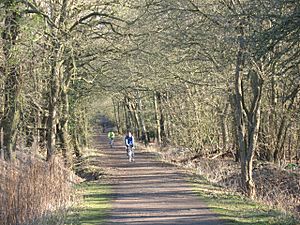
Walking is a popular activity in London. Places for walks include Wimbledon Common, Epping Forest, and the eight Royal Parks. You can also walk along the Regents Canal and other canals. Access to canals and rivers has improved recently. The Thames Path is about 28 miles (45 km) long within Greater London. The Wandle Trail follows the River Wandle.
Other long-distance paths connect green spaces. These include the Capital Ring, the Green Chain Walk, and the London Outer Orbital Path ("Loop"). The Jubilee Walkway and Diana, Princess of Wales Memorial Walk are also popular.
London's Sports
London has hosted the Summer Olympics three times. These were in 1908, 1948, and 2012. This makes it the first city to host the modern Games three times. The city also hosted the British Empire Games in 1934. In 2017, London hosted the World Championships in Athletics for the first time.
London's most popular sport is football. It has seven clubs in the Premier League for the 2023–24 season. These include Arsenal, Chelsea, and Tottenham Hotspur. Other professional men's teams in London include AFC Wimbledon and Millwall. Four London-based teams are in the Women's Super League.
Two Premiership Rugby union teams are based in Greater London: Harlequins and Saracens. Twickenham Stadium in southwest London hosts home matches for the England national rugby union team. While rugby league is more popular in northern England, London has one professional club, the London Broncos.
One of London's most famous annual sports events is the Wimbledon Tennis Championships. It is held at the All England Club in Wimbledon. It has been held since 1877. Played in late June to early July, it is the oldest tennis tournament in the world. It is also considered the most important.
London has two Test cricket grounds that host the England cricket team. These are Lord's and the Oval. Lord's has hosted four finals of the Cricket World Cup and is known as the Home of Cricket. In golf, the Wentworth Club is near London. Alexandra Palace in North London hosts the PDC World Darts Championship and the Masters snooker tournament. Other key annual events are the London Marathon and the University Boat Race on the Thames. This race is between Oxford and Cambridge.
Notable people
See also
 In Spanish: Londres para niños
In Spanish: Londres para niños







